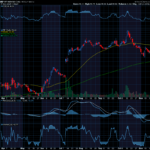by Darrell Jobman
Let’s say that you wanted to divide your $200,000 investment portfolio into two portions. First, let’s invest $180,000 in Dow Jones Industrial Average (DJIA) stocks to take advantage of the index basket concept without having to worry about selecting individual stocks. Then put the remaining $20,000 into S&P 500 Index futures. Using round numbers for our illustration, let’s say the S&P Index went from about 760 at the start of the year to 830 at the peak of Feb 19. Then it sank to 745 on April 14 before surging back up to the 900 level by the end of June. In each case, the percentage return was a point or two below the DJIA, as the blue chips attracted much of the investors’ attention during this time.
Applying the percentage changes in S&P Index points to the $20,000 invested in futures, you’ll see some of the biggest positives and negatives of futures. At the first peak, the futures account nearly tripled to $55,000. Then when the market fell 10%, the account dropped to $12,500, a decline of 37.5% from the beginning of the year, a rather discouraging outlook at that point. But from that low, the account multiplied more than six-fold by the end of June – a 287.5% gain for the futures portion of the portfolio.
Moving just 10 percent – $20,000 – of the portfolio into S&P Index futures helped the portfolio gain nearly $95,000 in six months, it rocketed overall returns from 20.7% to 47.4%! That’s more than double the dollar amount from the portfolio that contained only DJIA stocks!
This is one example of how the power of leverage from just 10% of your portfolio can make a substantial difference in your total portfolio returns. Who wouldn’t like to have those results?!

I want to share several things about the returns shown in this table. We have used simplified examples, based on percentage changes of indexes applied to the portfolio amount (they do not include commissions, fees, slippage or other variable costs). Therefore, they may not represent actual net returns on investment. Also, while the initial $20,000 invested in futures would have been enough to cover the margin of one S&P futures contract, it may not have been advisable for an account that small to have been trading S&P Index futures during the time period shown. However, nearly every investor can now include a stock index component in their portfolio with the smaller index contracts. Last, the return with using futures or options could have been greater than shown because it is as easy to sell those instruments as it is to buy. If you were short during the April dip and then had the foresight to buy again at the bottom of the dip, your returns would have been somewhat greater. These returns do not reflect any short sales, but this is one of the flexibility features that can make futures and options so attractive to many stock investors!












Recent Comments